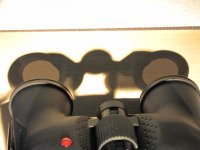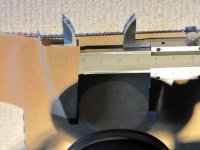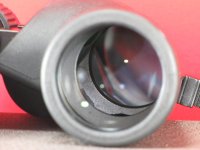RJM
Don't Worry, Be Happy!
Finally got around to running some tests on my #820 Audubon 8.5x44mm ED. Despite the generous eyerelief, I never have seen a sharp fieldstop with this bin unless I tilted my head to one side or the other as if I had to see over/around something. No matter as the views are nice and I assumed I was just having a tough time with wide AFoV even though seeing the fieldstop in my Nikon 8x30mm EII with a similar AFoV has never been a problem.
Well it seems this #820 is not a true 44mm aperture afterall! There is some mechanical obstruction of the lightpath, probably from the one internal baffle. Just to be sure it wasn't the rubber amor, I folded it back as shown in the first pic. The objectives do physically measure 44mm too.
Below are some pics I took of the test results. Shinning the uber-bright light from a Powertank from ~2m distant through the eyepieces (focused at infinity) and projecting onto a flat piece of cardboard results in the objective lens true aperture being illuminated on the cardboard.
Using a micrometer, I measured a true aperture diameter of ~40mm! I also verifed this measurement by using a loupe to magnify the hash marks of a transparent ruler held over objectives while focused on a distant building. FWIW, only at close focus does the aperture widen to 43mm when measured this way.
Exit pupil appears to be ~5mm but I can't measure this spec with better than
±1mm precision. Definately has more mag than my other 8x bins but less than my 10x so it is in the ballpark.
Still a bit of a disappointment though I don't yet feel inclined to throw the Audubon in the dumpster!8-P
happy holidays,
Rick
Well it seems this #820 is not a true 44mm aperture afterall! There is some mechanical obstruction of the lightpath, probably from the one internal baffle. Just to be sure it wasn't the rubber amor, I folded it back as shown in the first pic. The objectives do physically measure 44mm too.
Below are some pics I took of the test results. Shinning the uber-bright light from a Powertank from ~2m distant through the eyepieces (focused at infinity) and projecting onto a flat piece of cardboard results in the objective lens true aperture being illuminated on the cardboard.
Using a micrometer, I measured a true aperture diameter of ~40mm! I also verifed this measurement by using a loupe to magnify the hash marks of a transparent ruler held over objectives while focused on a distant building. FWIW, only at close focus does the aperture widen to 43mm when measured this way.
Exit pupil appears to be ~5mm but I can't measure this spec with better than
±1mm precision. Definately has more mag than my other 8x bins but less than my 10x so it is in the ballpark.
Still a bit of a disappointment though I don't yet feel inclined to throw the Audubon in the dumpster!8-P
happy holidays,
Rick
Attachments
Last edited:







